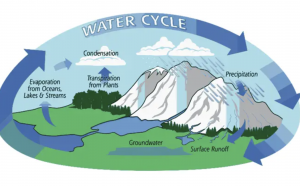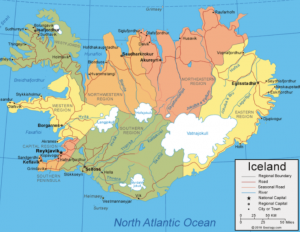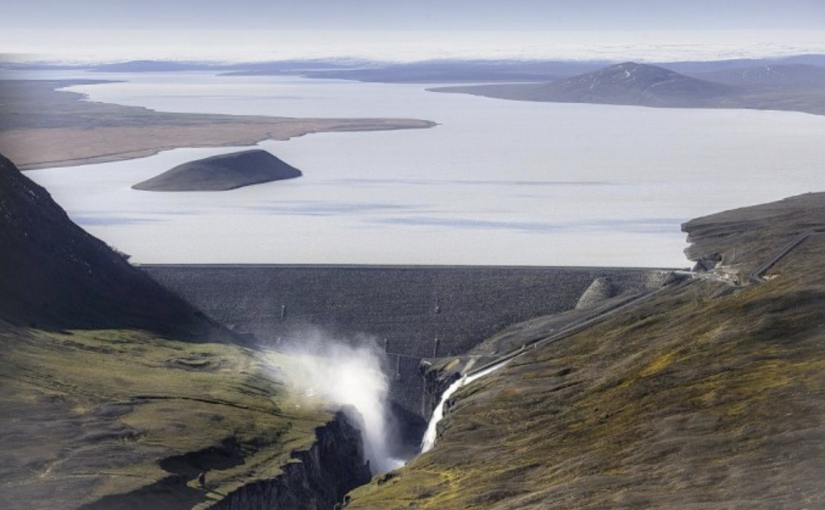What Is a Glacier?
A glacier is a dense, frozen mass made of compressed snow that has the ability to flow like a very slow river. It is part of the cryosphere which includes all the frozen elements of the hydrological (water) cycle. Glaciers cover 10% of the earth’s land surface area and hold roughly 69% of the earth’s fresh water.
How Does the Hydrological Cycle Work?

As you can see in the graphic above, the Hydrological Cycle, known colloquially as the water cycle, moves h2o (water) through the environment. Water is exchanged from liquid to gas by evaporation from ground sources like rivers, lakes, and the ocean. It then condensates (becomes denser) and forms clouds, which then precipitates and the water turns into a liquid form again as rain or solid form if it is cold enough as snow. This is where the cryosphere is involved! The snow helps form glaciers over a long period of time and allows for h2O to be stored as a solid, frozen form in a glacier. Since the hydrological cycle is cyclical, it follows the above pathway to distribute water throughout our environment.
How Does Climate Change Impact Glaciers?
Anthropogenic climate change is caused by humans burning fossil fuels that release Green House Gases (GHGs) into the atmosphere. GHGs trap heat in the earth’s atmosphere, which causes global warming, disrupts weather patterns and causes extreme natural disasters. Climate change has a BIG impact on glaciers due to it disrupting the Hydrological Cycle. Here’s how:
- Rising air temperature: As temperature rises across the critical 0 degree threshold (where water changes from a solid to a liquid), there is rapid ice melt.
- Increase liquid water: This catalyzed ice melt causes increase in runoff to tributaries, reservoirs, and dams (more on that later!) that are fed by the glaciers.
- Sea level rise: The increased liquid water from glacier eventually makes its way to the ocean, which cause an increase in sea level and has the potential to disrupt coastal populations.
Scientists know that for the next 150-200 years the rate of glacier melt is only going to increase, eventually plateauing, meaning that adaptive strategies in combination with efforts to reduce GHG emissions are the best path forward to a stable and sustainable future. Adaptive strategies are not limited to creating renewable energy sources, however. Check out some of the other policy issues on this website to learn about the diverse ways climate adaptation can be done.
Want to learn about other ways climate change is impacting the Arctic? Click here to learn about the difficulties Arctic Foxes are facing, and what solutions have been proposed to help save this species!
Case Study: Iceland’s Glaciers

Demography: Iceland is an island located just south of the Arctic circle in the mid-Atlantic ridge between tectonic plates, which means volcanic activity is common in the region. Iceland has a large frozen landscape and is home to many massive glaciers (you can see how big they are on the map above).
Glaciers: By 1985 scientists knew that Icelandic glaciers had retreated by nearly 2-5 kilometers, some of them losing up to 10% of their volume. They are able to measure change over time by using ice cores and examining the components of air bubbles trapped in the ice. Of serious concern to scientists, Icelandic policymakers, and Icelanders, in general, is the unusually warm summers due to climate change that are impacting the island. Many of the southeastern glaciers have ceased moving and are decaying/collapsing at a rate that is very disruptive to the environment impact by water that melts from the glaciers. One serious disruption is on Icelandic hydropower sources, specifically hydroelectric dams. Let’s explore this more!
How Does Hydroelectric Power Play a Role in Icelandic Energy Production?
Iceland generates 73% of its electricity, with the remaining 27% generated from geothermal sources. This means that Iceland is powered almost entirely by renewable resources, which are energy sources that can never be depleted, like coal. Hydroelectric power functions by builders creating a dam on a river that funnels water through a turbine. The turbine spins as the water moves through it and powers generators, which are connected to the electric grid. See the graphic below for a visual representation.

Iceland’s hydroelectric plants are connected to rivers and tributaries coming from the glaciers, and because they are melting so quickly, the power plants have to adapt and adjust to these changes. One particular powerplant, called the Karahnjukar Hydropower plant, was an enormous project that has 5 dams and created a reservoir that flooded 440,000 acres of highland.
Click here to see what the Karahnjukar Hydroelectric project looks like!
Positive and Negative Impacts of Glacial Melt
Positive Impacts:
- Helps Iceland meet its sustainable development goals vis a vis renewable energy production
- Economic benefit through ‘last chance tourism’ where people come to see the glaciers before they melt
- Access to hydropower
Negative Impacts:
- Cultural and identity loss as the glaciers decay and die
- Impacts the environment downstream including infrastructure
- Hyperfocus on hydropower development
Policy Recommendations
- Iceland should research and invest in other forms of renewable power, with a focus on geothermal, to ensure the long-term achievement of sustainability goals. The glaciers will eventually stop melting at the rate they are currently, and will perhaps melt completely if climate change is not mitigated.
- Iceland should ensure the voices and expertise of locals and hydroelectric planning sites to ensure downstream issues, such as farmland loss, are accounted for and mitigated.
- Want to learn about other locally-driven adaptation solutions? Click here to learn about the Alutiiq Pride Shellfish Hatchery in Alaska.
Click here to investigate climate policy created through an adaptive lens and what you can do!
Creative solutions are the key to working with our plant while climate change is happening. Mitigation strategies are super important in the effort to reduce GHG emissions, but the reality is anthropogenic climate change has already done some serious damage and will continue to do so. Adapting to our new environments and finding ways to grow from them, whether it be Arctic fox rehabilitation or community relocation, our future can be shaped by us and will not be defined by the devastating impact of climate change.
Watch this video to go into more detail![ensemblevideo version=”5.6.0″ content_type=”video” id=”1a81419c-6cbd-473e-9926-ffe750586d1f” width=”848″ height=”480″ displaytitle=”true” autoplay=”false” showcaptions=”false” hidecontrols=”true” displaysharing=”false” displaycaptionsearch=”true” displayattachments=”true” audiopreviewimage=”true” isaudio=”false” displaylinks=”true” displaymetadata=”false” displaydateproduced=”true” displayembedcode=”false” displaydownloadicon=”false” displayviewersreport=”false” embedasthumbnail=”false” displayaxdxs=”false” embedtype=”responsive” forceembedtype=”false” name=”Ailish O’Brien- A Balancing Act: Icelandic Glaciers and Hydroelectric Power”]
